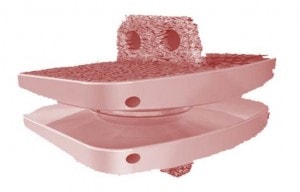Artificial Low Back Discs Release Metal Ions Too
Have you dealt with artificial low back disc complications? There’s been quite a scandal lately in the orthopedic device community over metal on metal hips that create wear particles and metal ions. What was called “hip resurfacing” is now surfacing as a huge problem as some of these patients are getting sick from their artificial hip. I recently came across a paper that surprised me, as it suggests that the same thing is happening in artificial low back discs.
I came across this first study while searching the National Library of Medicine Database for something else. In 15 patients, even at about 3 years after the placement of the artificial lumbar disc, patients had similar blood serum levels of Chromium and Cobalt to metal on metal hip replacement patients. The same group had also published an earlier paper showing the same thing. Like the metal on metal hips, there’s also evidence that in some patients, the immune systems is revved up by the metal ions. These papers focus on the Maverick Disc, which has more metal on metal contact than the ProDisc or Charite Disc currently in use in the United States. Of these U.S. devices, it’s likely that the ProDisc has some metal on metal contact, while the Charite disc would seem to have less, but less would still be too much.
The upshot? Like the problems seen in artificial knees and hips, it’s likely that any low back prostheses will cause wear particles that end up in the blood stream and these complications should be considereBased on what’s out there, the Maverick disc has been shown to have the same problem as metal on metal hips. It’s likely the other shoe will drop on the two used in the U.S. (ProDisc and Chartie), but we will await that research.

If you have questions or comments about this blog post, please email us at [email protected]
NOTE: This blog post provides general information to help the reader better understand regenerative medicine, musculoskeletal health, and related subjects. All content provided in this blog, website, or any linked materials, including text, graphics, images, patient profiles, outcomes, and information, are not intended and should not be considered or used as a substitute for medical advice, diagnosis, or treatment. Please always consult with a professional and certified healthcare provider to discuss if a treatment is right for you.

